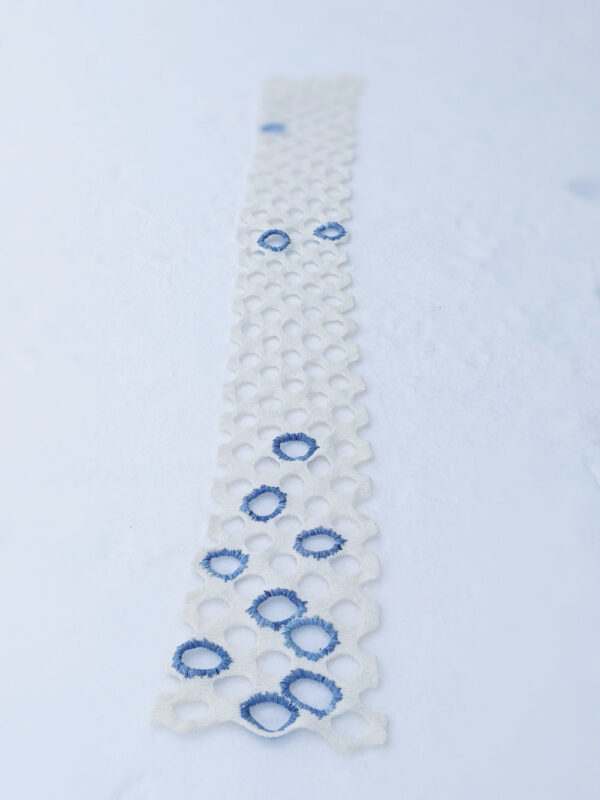Michale Glennon, Ph.D., is an ecologist who wants her work to represent “the inspiration and lessons found in nature.” She currently leads the Wool and Water project, which began in association with the 50-year anniversary of the Clean Water Act in 2022. Supported by the Lake Champlain Basin Program, it is a project that blends fiber art with scientific data to create visual representations of changing water conditions in the Adirondacks and Lake Champlain Basin. Glennon is always thinking about what’s going on in our environment and is also an “obsessed yarn person.” This project combines her two passions.
Interested in the effects of land use management on wildlife populations in the Adirondacks, she is engaged in researching all that this entails: issues of residential development, recreation ecology, and climate change. As a senior research scientist for the Paul Smith’s College Adirondack Watershed Institute (AWI), Glennon supports and helps shape the scientific research program, provides quality research opportunities for students, and “champions the work of the institute to improve the use of science in the management of the natural resources of the Adirondack Park.” Through long-term water quality monitoring and stewardship to prevent the spread of aquatic invasive species, AWI works to protect clean water and healthy watersheds in the Adirondack Park.

Greta. Named for climate activist Greta Thunberg, this piece was created before the Wool and Water project began. Based on data from NASA, which describes global temperature anomalies going back to 1880, the colors range from whites/greys through blues/greens to oranges/reds and align with data that depicts departures from baseline temperatures.
Glennon said it isn’t always easy to explain what’s going on in the environment to a general audience, or even to get them interested. Wool and Water presents a visual representation of scientific information, so people can “see” the changes. For instance, color, size, and variations in intensity can depict changes in temperature or the differences in clarity in the water over time. “I have had people say to me, ‘I wouldn’t have gotten that if you had shown me in a graph,’” Glennon said.
Wool and Water is a traveling exhibit; it is also a collaborative project. Most of the pieces were created by Glennon in the beginning, but she has since recruited other makers to contribute: knitters, crocheters, quilters, beaders, and more.

Ice Fishing Blues. This scarf illustrates the impact of warming winter temperatures on ice fishing. Each hole represents a winter since 1899, and those ringed with blue are winters in which the average winter temperature in the Adirondack region (December–February) was 25 or higher, a temperature at which ice fishing competitions are often at risk.

Champlain Ice Scarf. This scarf depicts the ice record on Lake Champlain. Each row represents a year between 1816 and 2019. The blue rows indicate years the ice did not freeze. White rows are the years the lake did freeze, with a bead placed in one of three columns to indicate the freeze date (January, February, or March).
Each piece created for the project is based on a set of data or a story, sometimes both. Consequently, each piece has its own message. “The aim of the project is to celebrate clean water and to highlight issues that impact the quality of our waterways,” Glennon said. She sees this project as a way to get people to engage with environmental issues. She and the other makers are using a variety of fiber arts to illustrate “concepts and trends related to our waterways, and hopefully to provide inspiration for their protection.”
“The response [to the project] so far has only served to further convince me that the most powerful connection between art and science is possibly in the incredible power that art has in the communication of science,” she said. She is thrilled with the response, especially from people who are not necessarily interested in science. Glennon is keen on getting more people involved, including children. Visit the website for more information: adkwatershed.org/wool-water.
Because of this project and the exposure it has received, Glennon has been asked to submit a piece for the Listening to Water Symposium, an event organized by Talking Rivers, which will include an exhibit at the Richard F. Brush Gallery at St. Lawrence University. Her piece is a translation of sound recorded near the Osgood River in the northern Adirondacks.
***
Barbara Delaney is a wordsmith, avid sewer, and quilter who makes her home in Massachusetts.
Top Image: Transparency. AWI partnered with the Finger Lakes Institute and the Wild Center in Tupper Lake, New York, to offer a workshop to high school students at the Adirondack Youth Climate Summit. The students learned about water sampling in the field and then had to work together to create a collaborative art piece using water quality data. The colors of these wool felt balls correspond to measured transparency in eight lakes in Hamilton County, New York. These lakes are among several lakes exhibiting trends of declining transparency.
Subscribe today and get our current issue FREE. Plus, get instant access to 20 original ebooks and 12+ years worth of digital magazines.

Over 120,000 fiber artists connect with Fiber Art Now through our various platforms – and we want you to join us! Connect and get inspired by contemporary fiber arts around the world.
For the latest news, special offers, and exclusive content you won’t find anywhere else, sign up for our newsletter below!